Don’t be fooled by greenwashing, “new teflon” isn’t that much different than old. Here is our list of PFAS, PFOA, and PTFE Free nonstick pans.
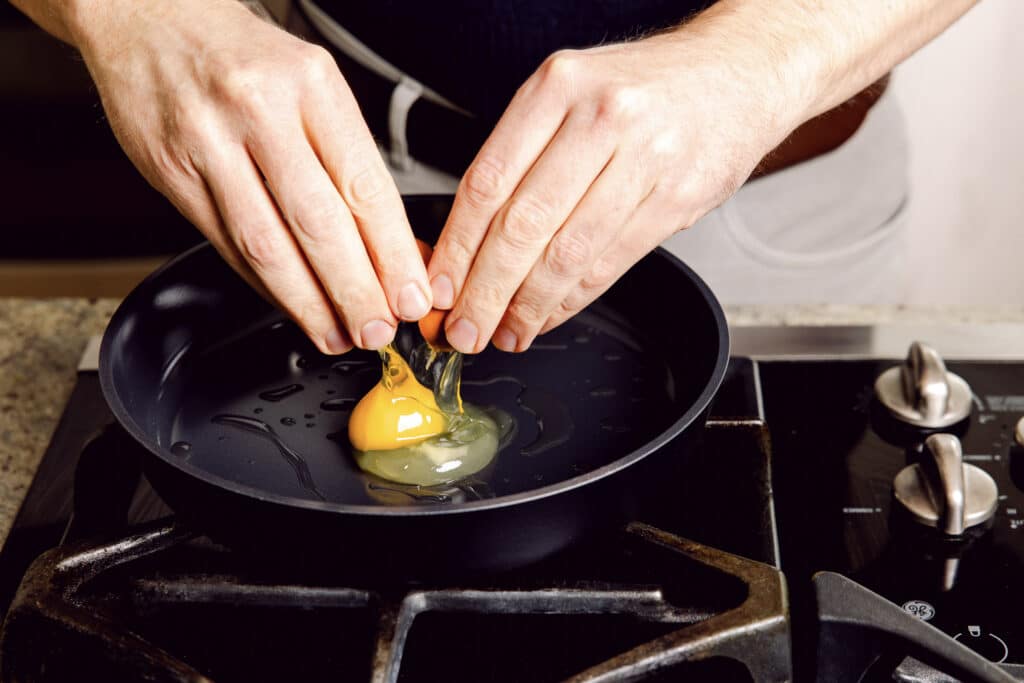
Table of Contents
As Leigh, our head of research, laid out in her post on the problems with Teflon, fluoropolymer coatings are generally made using poly- and perfluoroalkyl substances (PFAS) and were originally applied to cookware using solvents such as perfluorooctanoic acid (PFOA).
After serious health consequences were documented, a major lawsuit stopped Dupont, and other manufacturers, from using PFOA coatings in cookware.
In light of the dangers of these “forever chemicals,” many PFAS are now also banned from production, and the Biden administration plans to ban them from drinking water. Yet, this doesn’t mean you won’t still come into contact with them through older products.
One way to limit your PFAS exposure is to avoid most types of non-stick cookware, even products marketed as “green.” The coating on these pans can break down at high heat, leaving the potential for some unwanted ingredients in your stir fry.
Newer Teflon pans claim to be PFOA-free, but they still contain other compounds, such as a PTFE coating, which is also best avoided. One of the major pain points for consumers searching for truly non-toxic non-stick pans are the brands that market their products as PFOA free, but still use PTFE coatings on their pots and pans. None of these products made our list.
At only 10 pans, our list of the best non-stick pans is fairly short, but that is because of the prevalence of the “reliable” brands that market their wares as “Teflon-free,” while the coatings are still made using PTFE.
What To Look For in a Safe Non-Stick Pan
Nontoxic, nonstick pans come in a variety of styles. Here’s a look at the top non-toxic materials used today.
- Ceramic. This natural material is free of heavy metals and consequently can handle high-heat cooking. Cooks love ceramic cookware because it is safe for the stovetop, oven, freezer, dishwasher, and even the microwave. Ceramic is considered the safest cookware for high heat (up to 2500℉), though the pans tend to be fragile at these temperatures.
- Ceramic Coated. Get the benefits of ceramic cookware without the heft or price with ceramic coated pieces. They are non-reactive, can handle high heat (up to 600℉), are dishwasher safe, and offer an even heating surface. However, most aren’t compatible with the microwave, and the ceramic surface will scratch and eventually wear out.
- Carbon steel. Like your favorite cast iron skillet, carbon steel has a seasoning layer that naturally makes it nonstick. It’s thinner, lighter, and heats more quickly than cast iron, making it an excellent choice for frying pans and woks. Though carbon steel tends to be affordable, it’s incredibly durable and simple to clean. Just note it’s not microwave or dishwasher-safe.
- 3-Ply construction. The longest lasting, safest non-stick pans are those made with two layers of stainless steel over an aluminum core, covered with non-toxic ceramic. These pans are better able to resist warping, cracking, and bumps, and when the surface does wear away, the stainless steel itself is non-toxic.
Our top picks
Below, we’ve highlighted the best nontoxic, non-stick pans available today. Each has its advantages, but every product mentioned here will give you the security of knowing you are cooking on a safe surface that won’t release toxic fumes at high heat.
- Price: $89-$129
- Materials: Ceramic-coated aluminum with stainless steel welded handle
- Specs: 8-inch, 9.5-inch, and 11-inch options
- Country of Origin: China
The Maestro frying pan is a gorgeous, finely balanced, truly non-stick frying pan made by a sustainable, longstanding Belgian cookware company. Alva Cookware began by using recycled materials and continues that practice today. It also ships everything in recycled and recyclable packaging with minimal or no plastic.
This pan is totally PFAS-free and does not leach any toxic chemicals or metals (I’ve seen the test results). You can use this pan in the oven up to 200 F, but it isn’t dishwasher safe.
The Maestro is available in three sizes and has straight sides to maximize cooking surface area. It is genuinely non-stick and easy to clean, and the stay-cool handle actually stays cool.
This pan works on all cooktops, including induction. The thick stainless steel pan has an aluminum core for really even heat conductivity and it warms up fast too.
My wife loves this pan so much that she insisted we take it on a recent cabin trip where we were meant to be packing light! And I’m glad she insisted, because it meant we got perfect crepes while on vacation! The pan is really well made, with a lovely balance between handle and pan. It is so much easier to move around than a solid ceramic or cast iron pan, and the non-stick ceramic surface barely needs any oil to keep food sliding around with ease. It makes for perfect pancakes and much more, with a lovely sear on tofu, veggies, sausages, etc.
Read more about my experience with Alva Cookware here, and why I trust their test results.
- Robust third-party testing for forever chemicals
- More affordable than competitors
- Well made, easy to cook with
- Works on induction cooktops
- Some cookware by Alva is heavier than competitors, which is a sign of quality, but also makes it tougher to handle for some.
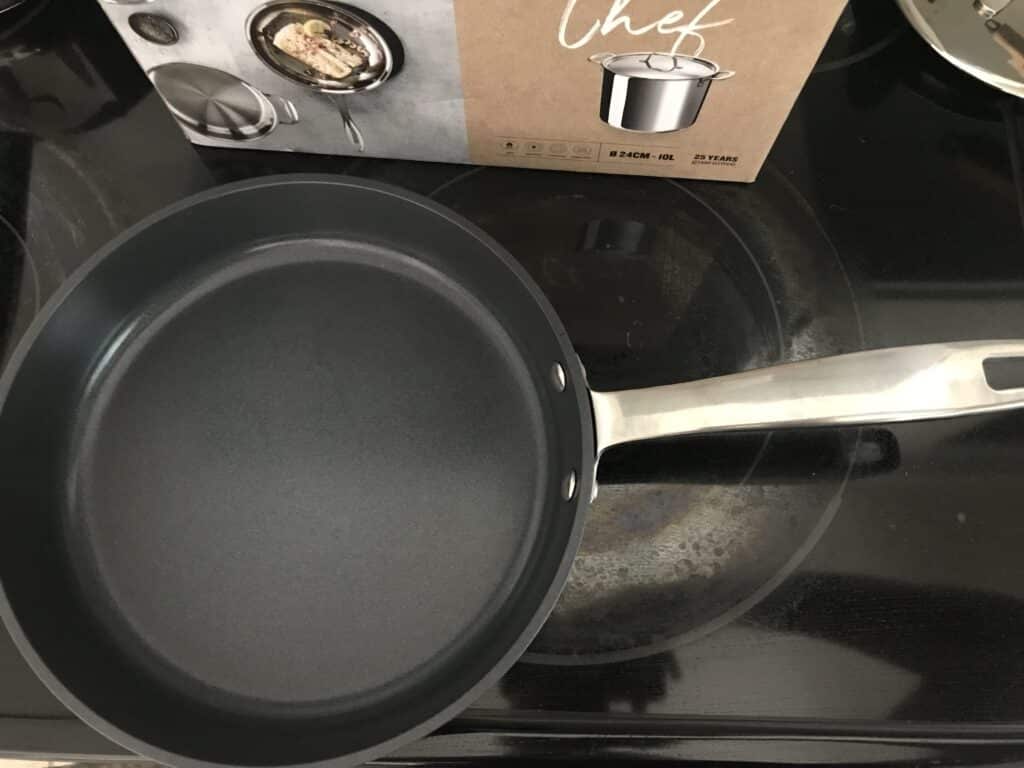
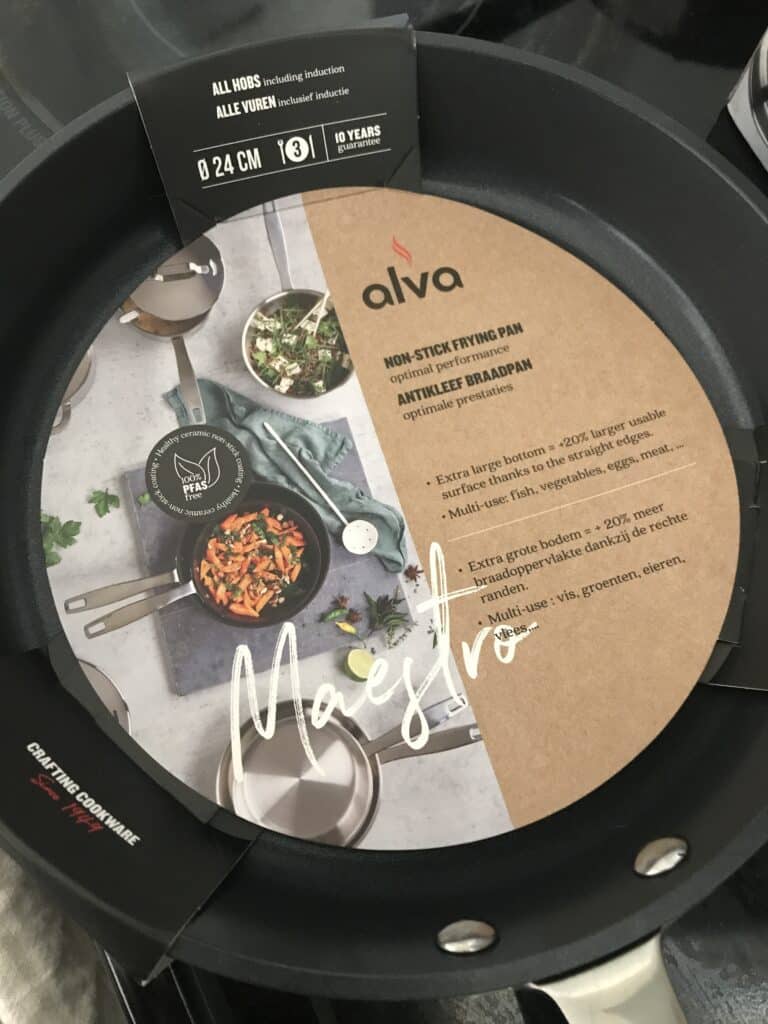
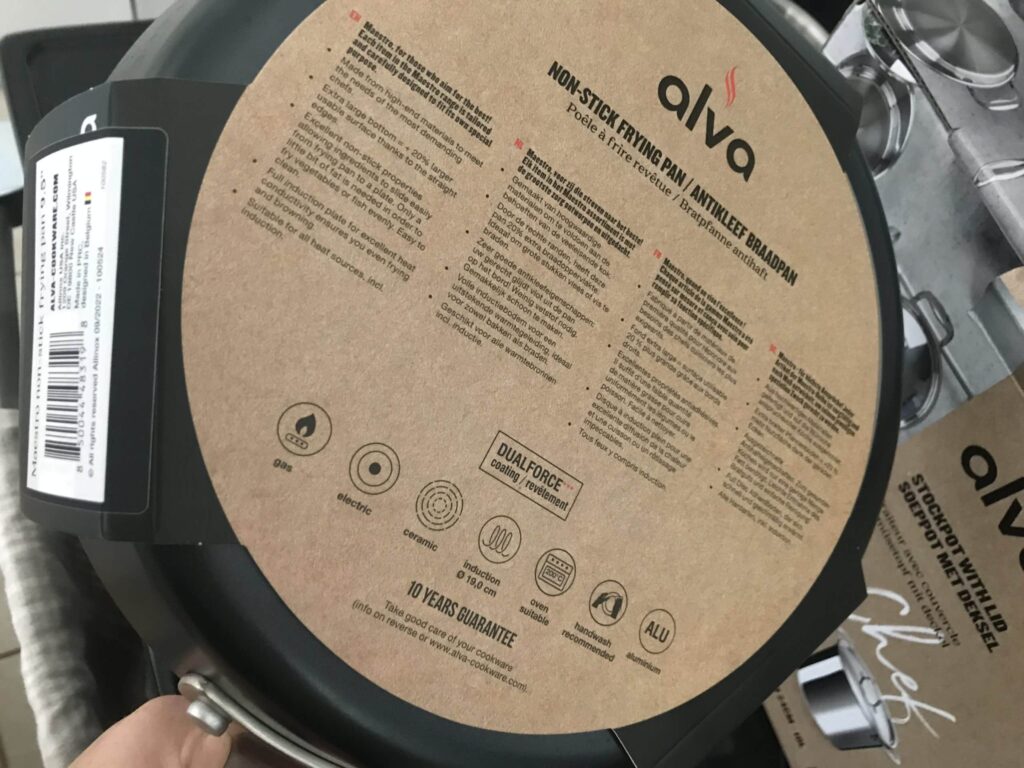

- Price: $95
- Materials: Ceramic coated aluminum with a steel bottom (induction-friendly!)
- Specs: 2.8lbs, 10.5 inches, 2.7 qt capacity
- Country of origin: China
This nontoxic fry pan offers a Teflon-free (PTFE free) cooking space that’s coated instead in a durable ceramic interior. It boasts a nonstick interior that will stand up to high temperatures while letting you cook with less oil. The pan’s relatively thin design means it will heat up fast, and the ceramic coating should withstand heavy use without damage.
One major drawback—Caraway doesn’t sell a compatible lid.
Leigh’s note: Caraway is a fantastic, transparent cookware brand that has third-party testing for all its products and ships everything in sustainable packaging without single-use plastics. It’s also induction-friendly, meaning you can use this cookware with the most efficient cooktops!
Although the pan is recommended for lower heat settings, we didn’t find it a drawback. Overall, we love Caraway as a rare brand with beautiful products that doesn’t cut corners when it comes to safety. The peace of mind we are looking for with non-toxic non-stick is 100% PFOA and PTFE free, and Caraway checks both boxes. The Caraway frying pan does require just a smidge of oil to be truly non-stick, but we had no issues sautéing a salmon filet without any skin sticking to the bottom of the pan.
- Truly non-toxic
- Beautiful design
- Non-stick with just a little oil
- Enough depth for making sauces or oatmeal
- Easy to clean
- Doesn’t comes with a lid
- Not as durable over time
- Shows stains and chipping in nonstick surface after one year
- Aluminum pan (not stainless steel over aluminum)
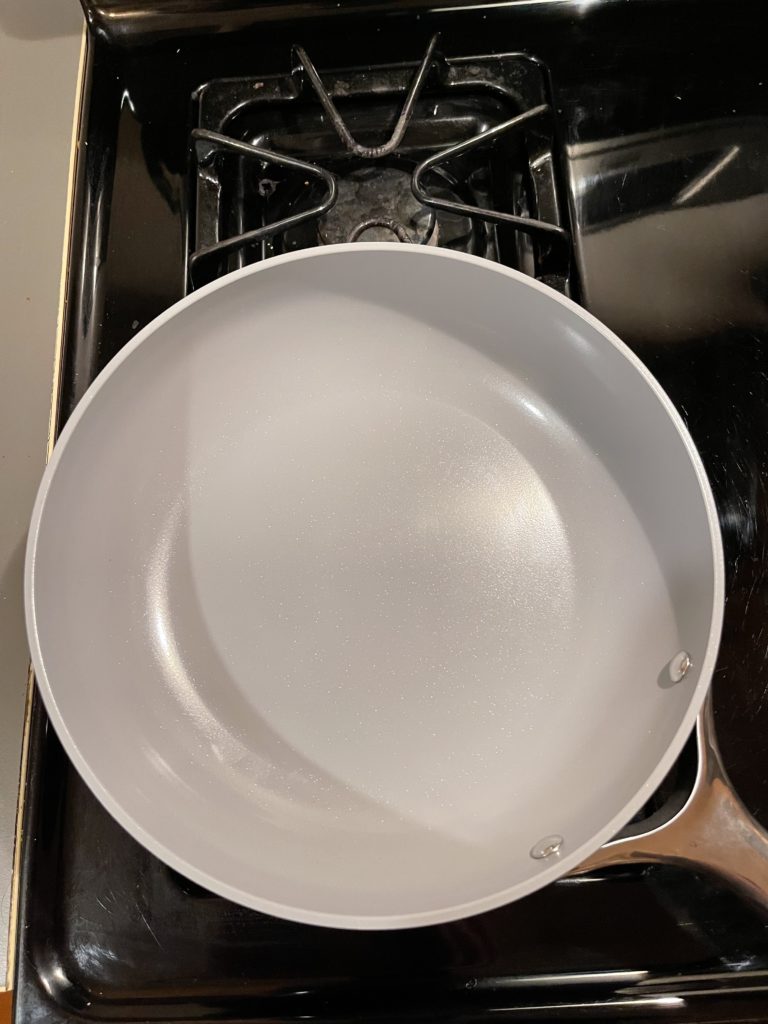
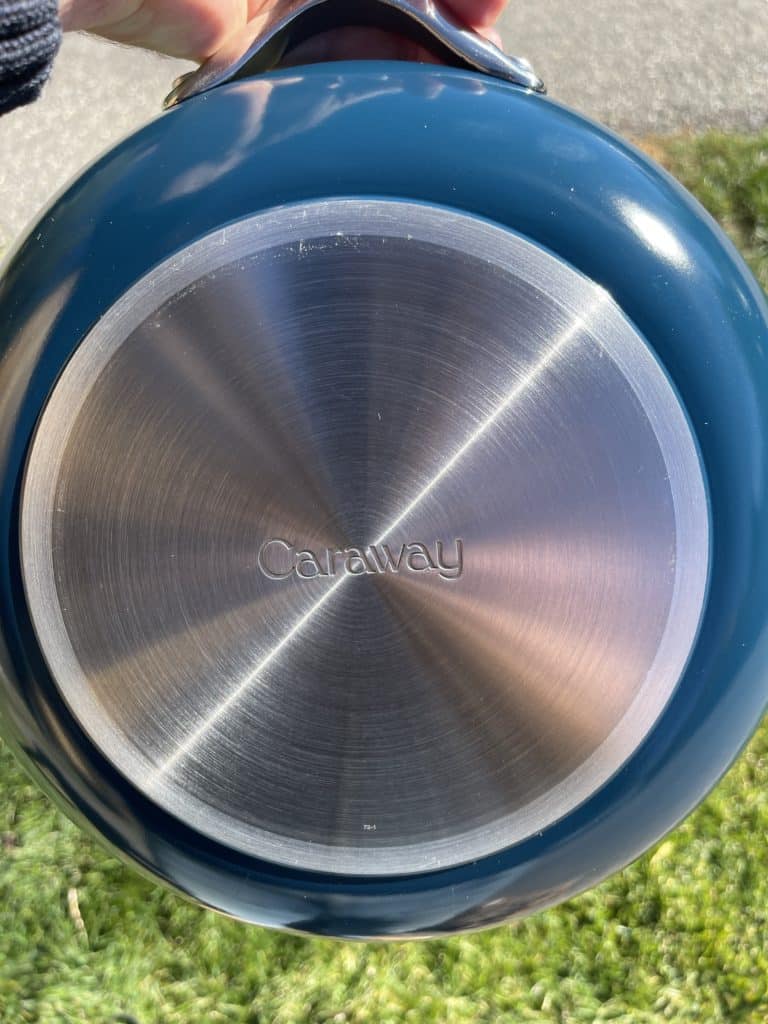
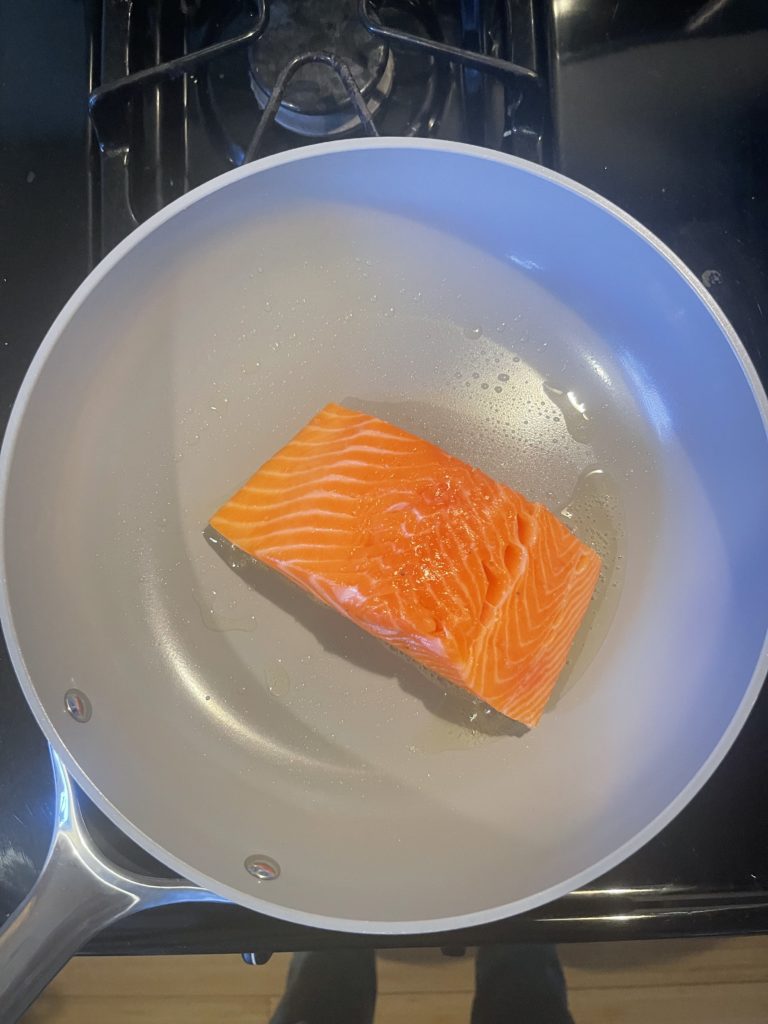
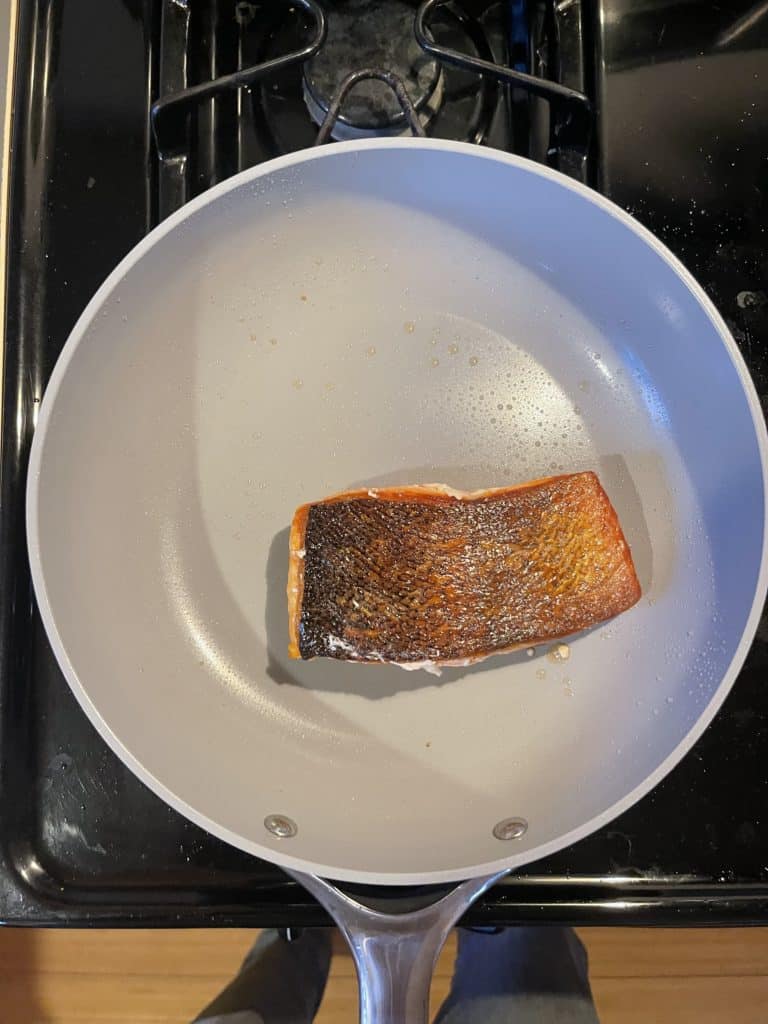
- Price: $169.99
- Materials: Ceramic
- Specs: 10lbs, 10.5 inches, 2.5 qt capacity
- Country of Origin: China
Xtrema is one of the few brands that sells 100% ceramic cookware. The pure ceramic build means the skillet won’t leach any toxins into your food, but you might sacrifice some performance because of it. For example, it can’t be used on induction stovetops, and fragile foods like eggs tend to stick to it. The ceramic material is also very fragile at high temperatures, and the pan itself doesn’t tend to heat evenly.
Still, this skillet is scratch-resistant and straightforward to clean, even if you get some sticking. It’s also oven and microwave safe, and Xtrema provides silicone handles for use with the skillet to protect your hands.
Suffice to say; if you’re committed to cooking with pure ceramic cookware, this is one of the best brands you’ll find.
What’s not readily apparent from pictures is the depth of the Xtrema skillet. Home chefs can use the pan for sautéing, frying, or even for boiling a smaller portion of pasta. The depth gives the pan quite a bit of flexibility. If used correctly, these pans are built to last. However, they aren’t as non-stick as some competitors and you will need to add some cooking oil for a true non-stick experience. The reason to buy Xtrema is because of their high level of transparency when it comes to safety and purity, and for longevity. Other, newer brands, like Caraway get the slight edge for pure non-stick function, but it’s likely Xtrema products will outlast them.
- Beautiful quality and aesthetic
- Enhanced pan depth for versatility
- Transparent third-party testing to ensure Xtrema is free from PFAS, PTFE, and PFOA
- Not truly non-stick
- Made in China

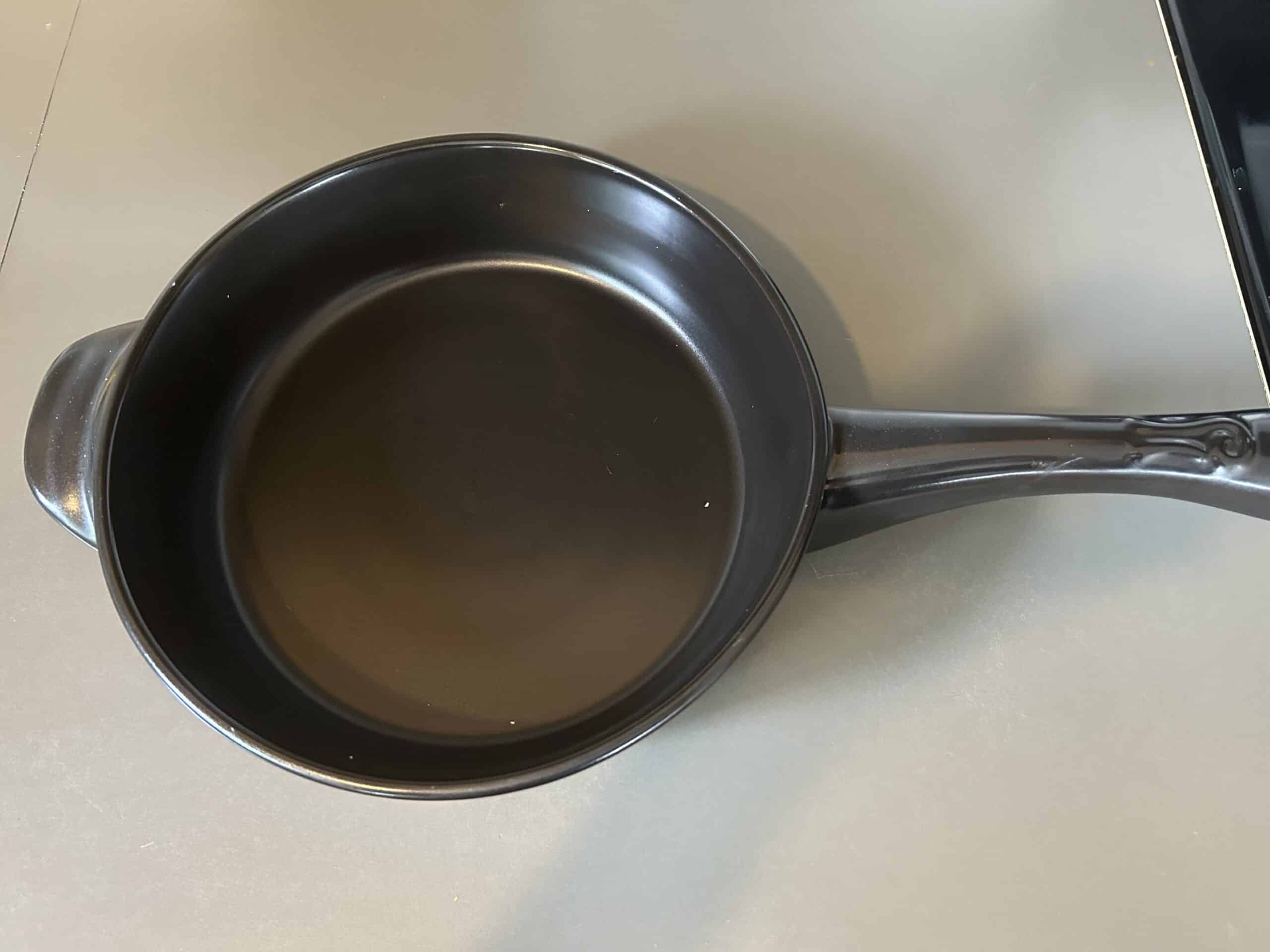
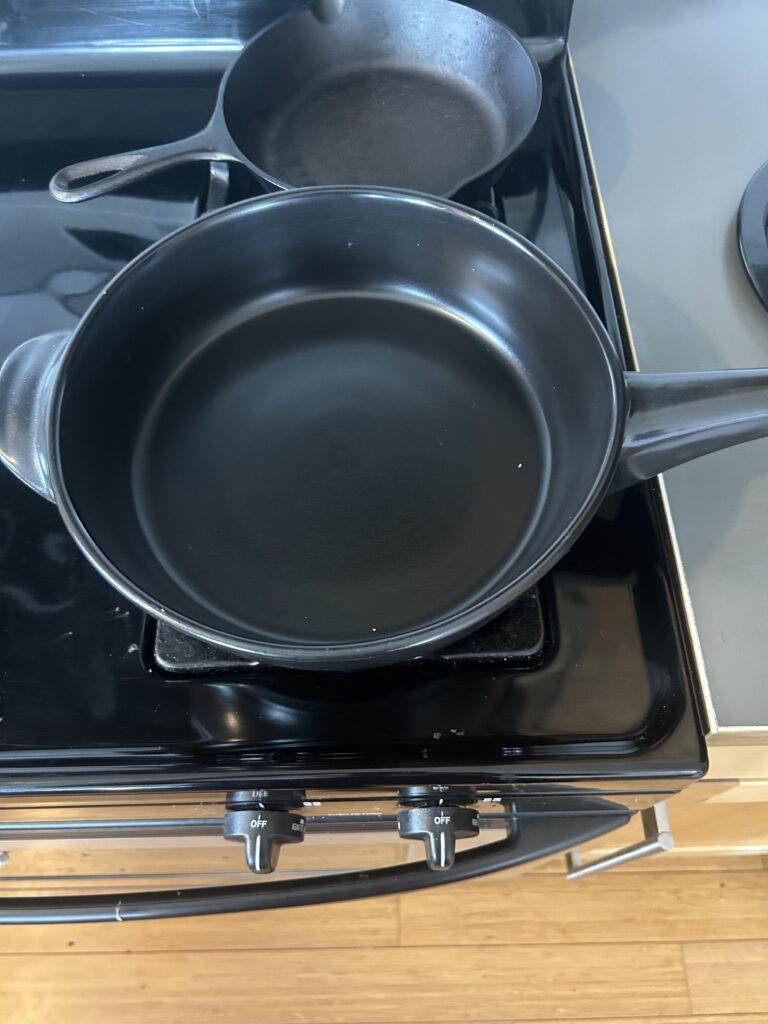
Xtrema is offering LeafScore readers 10% off their purchase using coupon code LEAFSCORE at checkout!
Free eBook: Simple Steps to a Greener Home
Concerned about climate change? Learn actionable tips for making each room in your home greener.
"*" indicates required fields
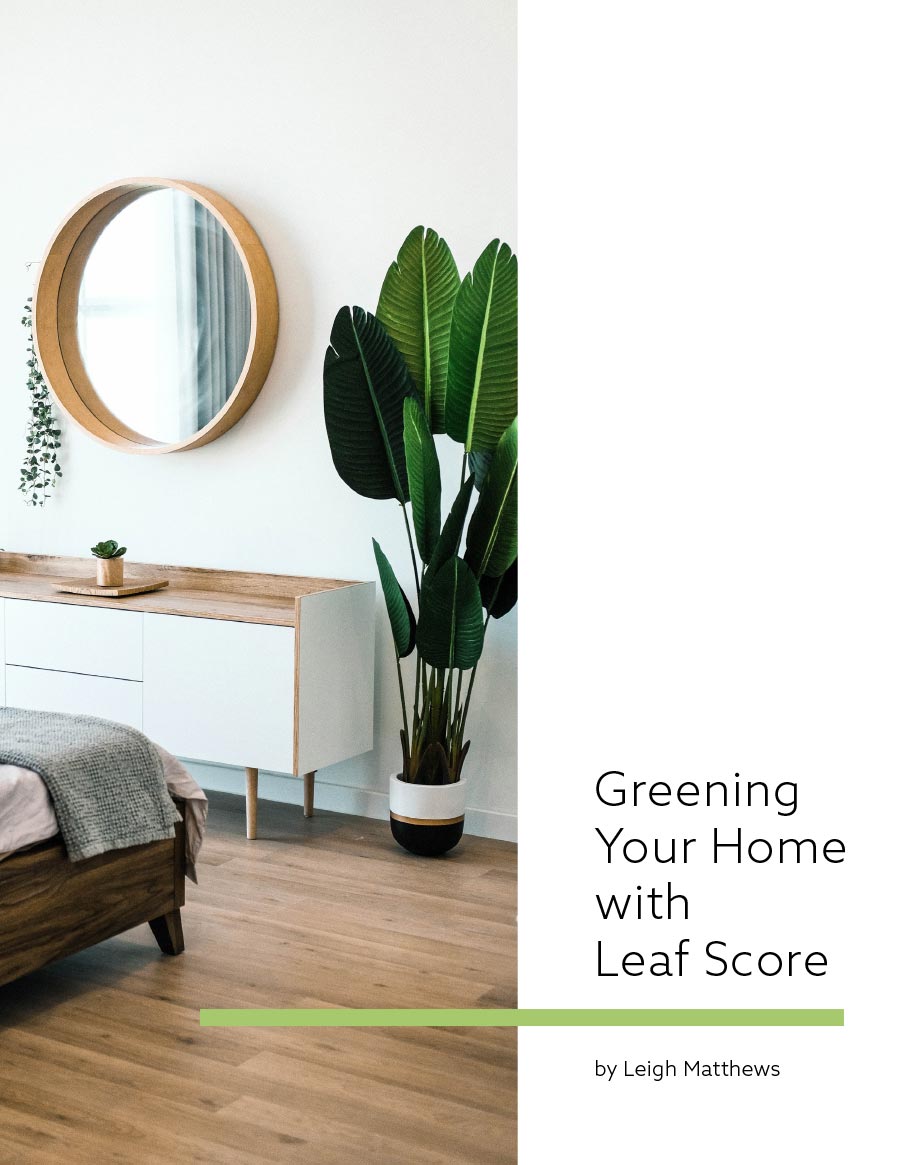
- Price: $49.95 to $109.95
- Materials: 99% iron / 1% carbon
- Specs: 8-inch model: 5.5-inch cooking surface, 2.2 lbs. 14-inch model: 10.25-inch cooking surface, 7.8 lbs
- Country of origin: France
This French-made pan is lighter than cast iron but handles high heat just as well. You can move it from the stovetop to the oven with ease, and each pan works for baking, browning, sauteing, and even searing meat. (Note: it’s only rated for ten minutes of oven cooking at 400F).
The cooking surface is made from 99% pure iron and includes a signature beeswax finish to help the seasoning and reduce oxidation. This naturally nonstick surface requires regular seasoning, but with the right care, you should expect your pan to last for decades.
It’s a smart choice for anyone who likes cooking with woks, and the pan improves the more you use it. Just make sure you can commit to handwashing it, so you don’t ruin the seasoning.
We tested the De Buyer Mineral B Pan in our home kitchen. The product looks and feels beautiful, but the seasoning is difficult to maintain.
- Great looking
- Durable
- Oven-safe
- Excellent green credentials
- Seasoning very difficult to maintain
- Pan blackens immediately when using higher heat causing lasting stains
- Will require plenty of avocado oil to be truly nonstick
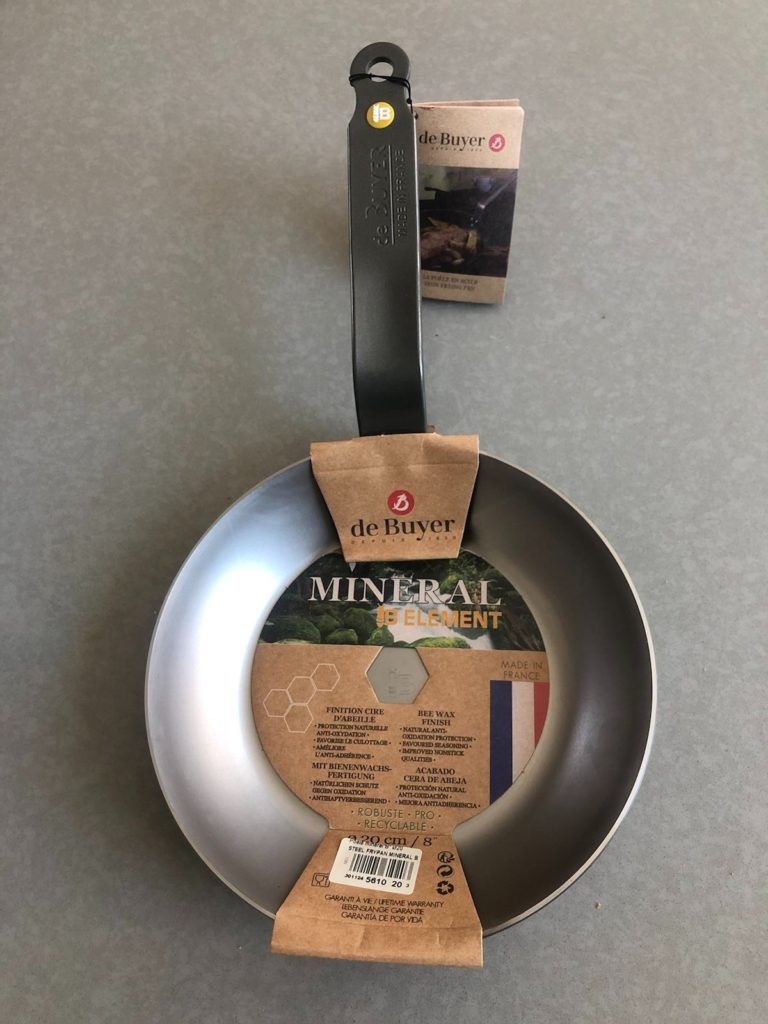
Note that De Buyer also makes some non-stick pans with a PTFE surface. The carbon steel pans are PTFE-free, but for other pans, you’ll want to check listings carefully.
- 5-ply stainless steel pans with aluminum core
- PTFE-free, thick, durable, non-stick ceramic coating
- Metal utensil safe
- Dishwasher safe and easy to clean
- Oven safe to 600 F
- Induction friendly
- Warp resistant and boasts excellent heat conductivity
- Stay-cool stainless steel handle and helper handle
- Stainless steel, oven-safe, low dome lids
- Trimmed edges to prevent damage to ceramic interior
- Inexpensive and long-lasting
- GreenPan has good sustainability initiatives
- GreenPan doesn’t reveal its toxicity test results
- No clear idea of what’s in the Infinite8 coating
Greenpan’s GP5 Stainless collection features the latest iteration of GreenPan’s ceramic non-stick coating over an impressive 5-ply pan body.
These pans look great and have some good heft, thanks to their 5-ply construction. There are two outer layers of stainless steel with three layers of aluminum in the middle. The result is better heat conduction and a more warp-resistant base than less robustly built pans.
Infinite8 ceramic non-stick is thick, diamond-infused, and reportedly very durable. It is even safe for use with metal utensils, which is rare for ceramic coated pans. And it’s oven-safe to 600 degrees, which strongly suggests these pans are well made and warp-resistant.
I also like the reverse rivet design, which helps prevent food getting stuck around exposed rivets. This makes it much easier to keep the pans clean, so they stay non-stick for longer.
Still, if you do choose the latest GreenPan pans, it’s best to avoid metal utensils, warm and cool pans slowly to avoid thermal shocks, and wash the pans by hand instead of in the dishwasher.
GreenPan also wins points for its environmentally friendly practices, including use of renewable energy and its sustainability program where you can return old cookware for recycling.
- PTFE-free Thermolon Advanced ceramic coating
- Tempered glass lids (oven-safe to 425 F) with pour spout and drainer
- 3-ply stainless steel pans are oven-safe to 600 F
- Induction-friendly with warp-resistant base
- Dishwasher safe and metal utensil safe
- Fast and even heat conduction
- GreenPan doesn’t reveal what’s in Thermolon
- Rivets aren’t reversed, so food can get stuck
- Not quite as robust as the GP5 5-ply collection
GreenPan’s Venice Pro collection boasts the company’s second best coating, Thermolon Advanced, over a 3-ply stainless steel pan body with an aluminum core. The ceramic non-stick coating is thick and durable, metal utensil safe, and oven-safe to 600 F.
This collection comes with glass lids, which is great for seeing what you’re cooking without having to release heat or steam. The lids are only oven-safe to 425 F, though, so don’t get caught out.
The Venice Pro pans have stainless steel stay-cool handles and are dishwasher safe. The lids also have a built-in strainer and pour spout, for less mess.
- Looks amazing… at first
- Very non-stick and slippery… at first
- Lightweight – much lighter than cast iron or pure ceramic
- Requires only low to medium heat (saves energy)
- Meant for small kitchens with little storage space
- Enough volume to cook big meals to share
- Some lovely and smart design features
- Great choice of colors
- Works with all stovetops (though some issues with induction)
- Smart, sustainable packaging great for gifting
- No third-party test results available for toxicity
- Non-stick surface seems to get sticky after six months on average
- Helper handle gets dangerously hot
- Long handle is bulky, boxy, and uncomfortable to hold
- Hard to clean after six months or one sticky spillover
- Steamer basket sits very low in pan, risking boiling or boiling dry
- Fussy care and use rules to avoid damage
- Staining and discoloration compromises aesthetic after six months or less
The Always Pan 2.0 has become the go-to non-stick pan for my wife when she cooks dinner. Personally, I stick to my Alva or cast iron as I’m still on the fence about the safety and durability of the Always Pan.
After more than four months of use, the Always Pan 2.0 remains impressively non-stick. Even more so than the Alva Maestro pan. It also still looks great, suffering none of the tarnishing we’ve seen with the Caraway non-stick frying pans.
Unfortunately, Our Place, the makers of the Always Pan, won’t reveal any third-party testing, even when I’ve asked them directly with the promise not to publish anything proprietary. That means we don’t know exactly what’s in the non-stick coating, nor if it would pass more rigorous leach testing. The pans must pass California Prop 65 tests, though, given that they’re sold in California without a Prop 65 warning.
Aside from the concerns over toxicity and non-stickiness wearing out fast, the Always Pan 2.0 has some design quirks that you’ll either love or hate. The boxy handle is uncomfortable, for example, and the helper handle gets dangerously hot (don’t touch it without silicone grips or an oven mitt). The pan is also bulky and hard to fit into a cabinet without fear of it being knocked or scratched by other cookware.
The 10-in-1 idea is also a little silly, given that the steamer basket sits so low in the pan that there’s no way you can cook anything beneath it. As such, if you want to steam and fry things simultaneously, you’ll need another pan or pot. This pan also isn’t oven-safe above 430 F, which is a lot lower than many other non-stick pans on this list and suggests less robust construction.
Despite all my misgivings, this pan does look great and works very well as a non-stick frying pan. I do like the steamer too, and the two pour spouts are a nice touch. This pan is also incredibly easy to keep clean (so far).
Bonus: The Best in “Nearly Nonstick”—Cast Iron and Porcelain Enamel Cookware
Though these two materials don’t fit the technical definition of what most of us consider nonstick cookware, we think they deserve a second look. Both offer a non-toxic cooking surface that, when properly maintained, cooks beautifully and couldn’t be easier to clean.
Here’s a summary of these materials and a closer look at two of the best options available.
- Cast iron: As the original ‘nonstick pan,’ cast iron takes some getting used to, but it offers an ultra-durable, versatile cooking surface. Their seasoning layer makes for a naturally nonstick surface, and you can use the same pan to do everything from searing, sautéing, baking, broiling, frying, grilling, and even cooking over a campfire. Cooks love how well cast iron retains heat, but these pans are heavy, tricky to clean, and may rust if you let them dry wet.
- Porcelain Enamel: This cookware is typically made from cast iron that is coated with enamel. This gives you the even-heating benefits of this traditional material without having to worry about rust or keeping the pan seasoned. Porcelain enamel wins points for ease of use and simple cleaning, but the pans tend to some of the priciest available. You can also damage the pan’s surface if you use metal utensils within it.
- Price range: $24.95 – $49.95
- Materials: Cast iron
- Specs: 8-inch model: 8.75-inch, 3.17lbs, 0.14 qt. 12-inch model: 12.79-inch, 6.55 lbs, .39 qt.
- Country of origin: USA
Lodge has long been the leading name in cast iron skillets, and for a good reason. The company has sold affordable, long-lasting cookware made in the United States for decades, and with the right care, you can expect each piece to last for generations.
Read our full Lodge cast iron skillet review.
Every Lodge cast iron pan comes pre-seasoned, so it’s ready to use right out of the package. Its cooking surface is naturally nonstick, though you’ll still want to use some cooking oil for most dishes.
The Chef Collection skillet beats out the brand’s standard model with extra features designed to make kitchen work easier. This includes an ergonomic handle, pour spouts on the sides for better handling sauces and gravies, and sloped sidewalls to ease stirring with a spatula. As with all cast iron, you can use this pan just about anywhere—from your induction stovetop to a campfire.
Keep in mind that this pan requires gentle handling as you clean it to prevent rust and maintain the seasoning layer. Never leave it wet, and never put it in the dishwasher.
An old Lodge Cast Iron Skillet, as well as one of their mini-models, is a staple in our home kitchen. We’ve used these pans for years, and love their ability to season over time.
- Seasons over time
- Durable
- Oven-safe
- Versatile (can be used for stir fry or fish/meat)
- May need some extra oil to be truly nonstick depending on seasoning
- May be too heavy for older kids and the elderly
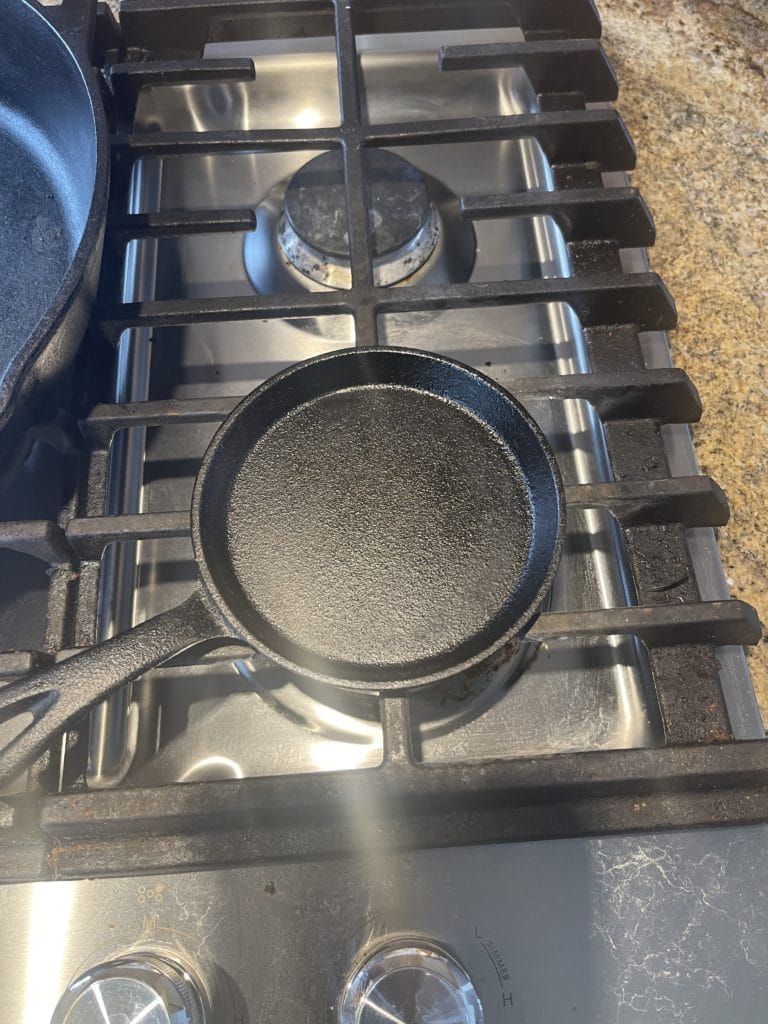
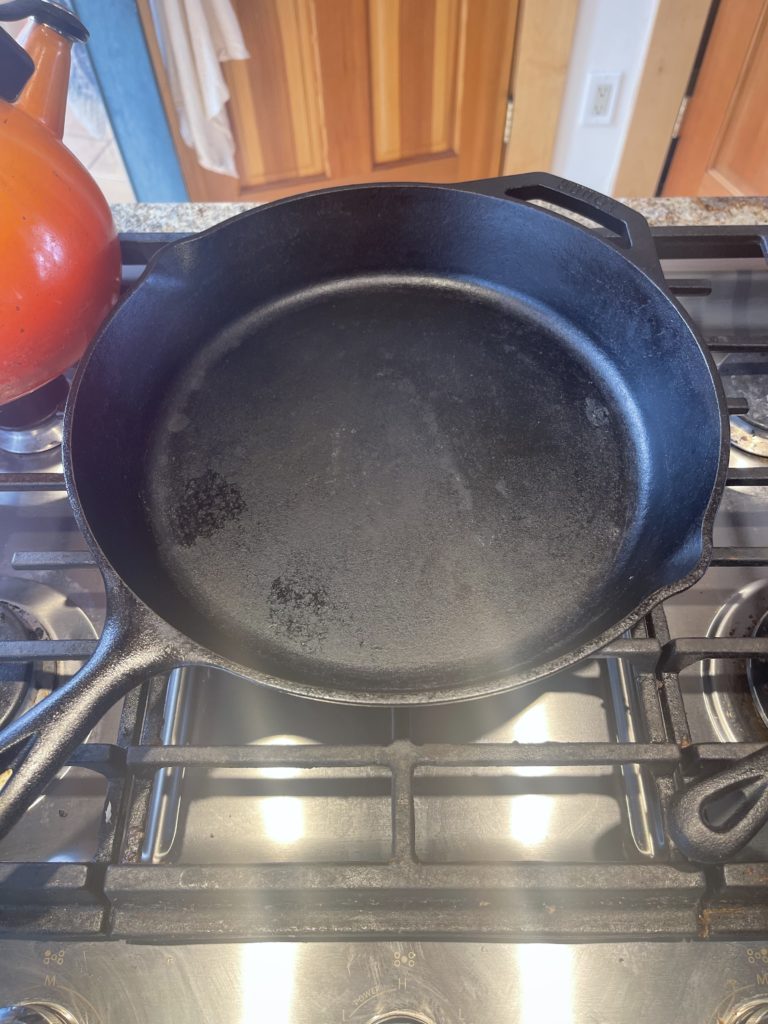
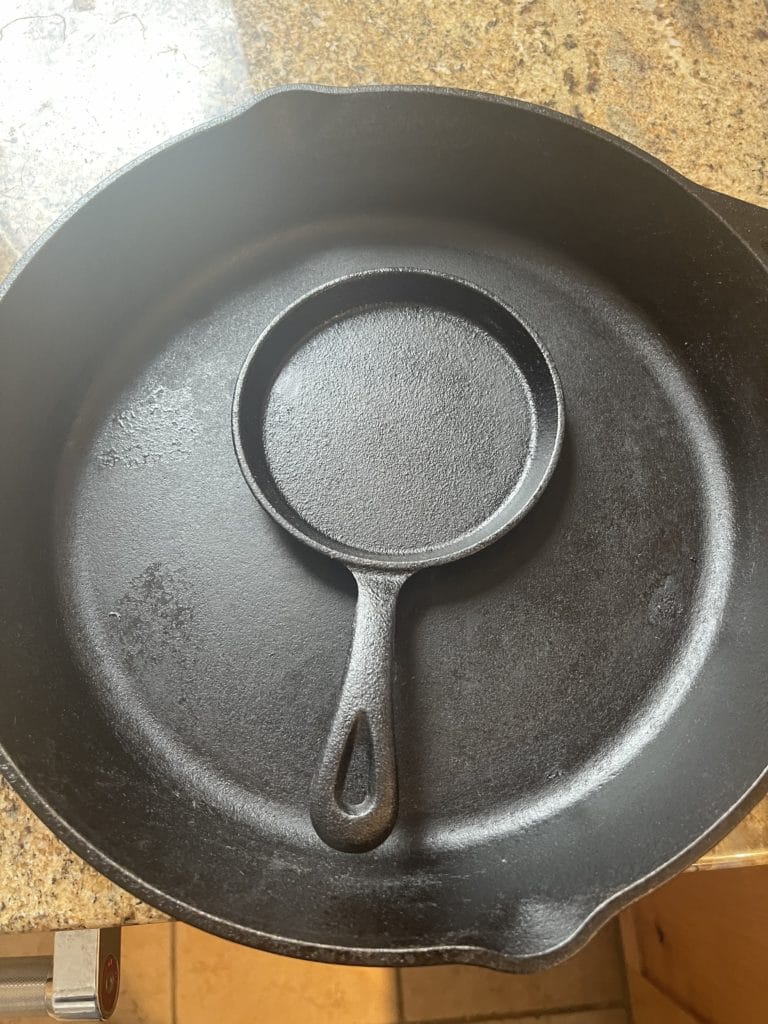
Free eBook: Simple Steps to a Greener Home
Concerned about climate change? Learn actionable tips for making each room in your home greener.
"*" indicates required fields

- Price range: $120 – $205
- Materials: Enameled cast iron
- Specs: 6 ⅓ inch model: 10.24 inches, 2.82lbs. 11 ¾ inch model: 13 ½ inches, 6.5lbs
- Country of origin: France
As one of the premier names in gourmet kitchen cookware, Le Creuset’s Signature Skillet doesn’t disappoint. It boasts an enameled cast iron surface that is naturally less sticky and eliminates any need for the material’s traditional seasoning and maintenance. In fact, this enamel is formulated for high-temperature cooking (it’s oven-safe to 500F) and develops a natural patina over time that keeps it easy to clean.
Note: Le Creuset’s non-stick cookware is made with PFAS, so stick to the cast iron and enameled cast iron.
Cooks love this skillet’s ergonomic design and heat retention abilities, as well as its durable porcelain enamel that rarely chips and is dishwasher safe. It’s relatively light for cast iron, which makes it more maneuverable around the kitchen.
If you’re serious about your nontoxic cookware, this is a pan worth considering, despite the high price. Just keep in mind that it’s not 100% nonstick and that you will need to use small amounts of cooking oil for delicate foods like eggs and fish.
We cooked an egg in a Le Creuset signature skillet to test its nonstick abilities. The middle picture represents the small amount of a fried egg that stuck to the pan after we fried the egg.
- Excellent quality and durability
- Range of colors
- Peace of mind that the product is non-toxic
- Excellent heat retention
- Not 100% non-stick
- Extra oil is needed to cook
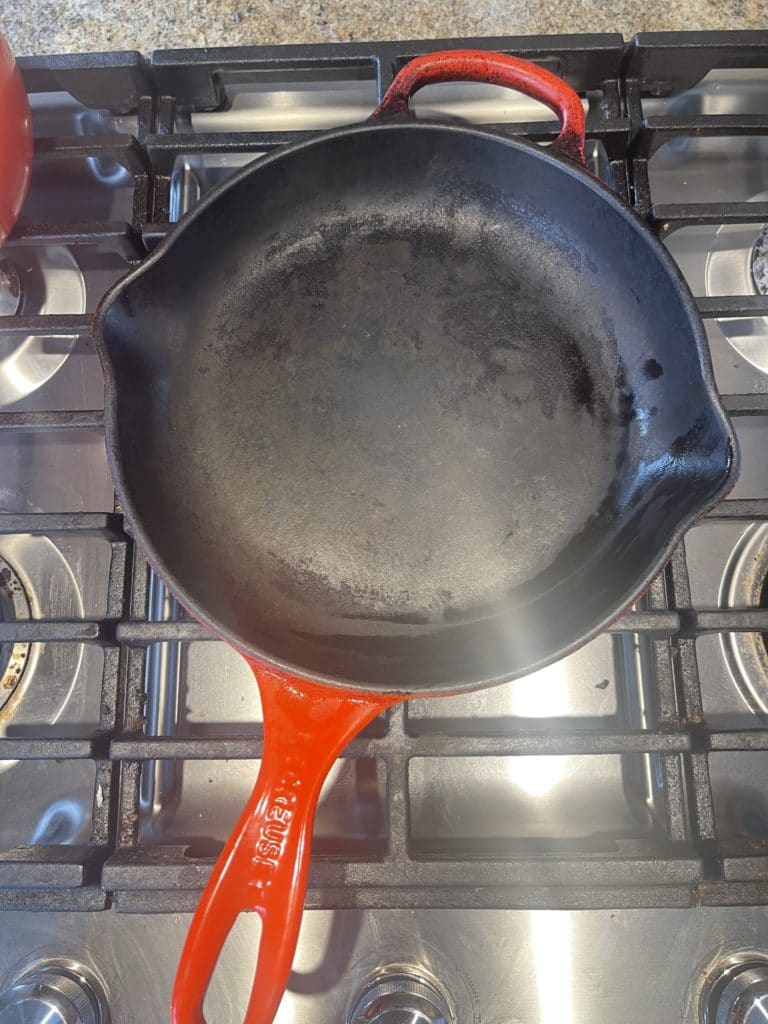
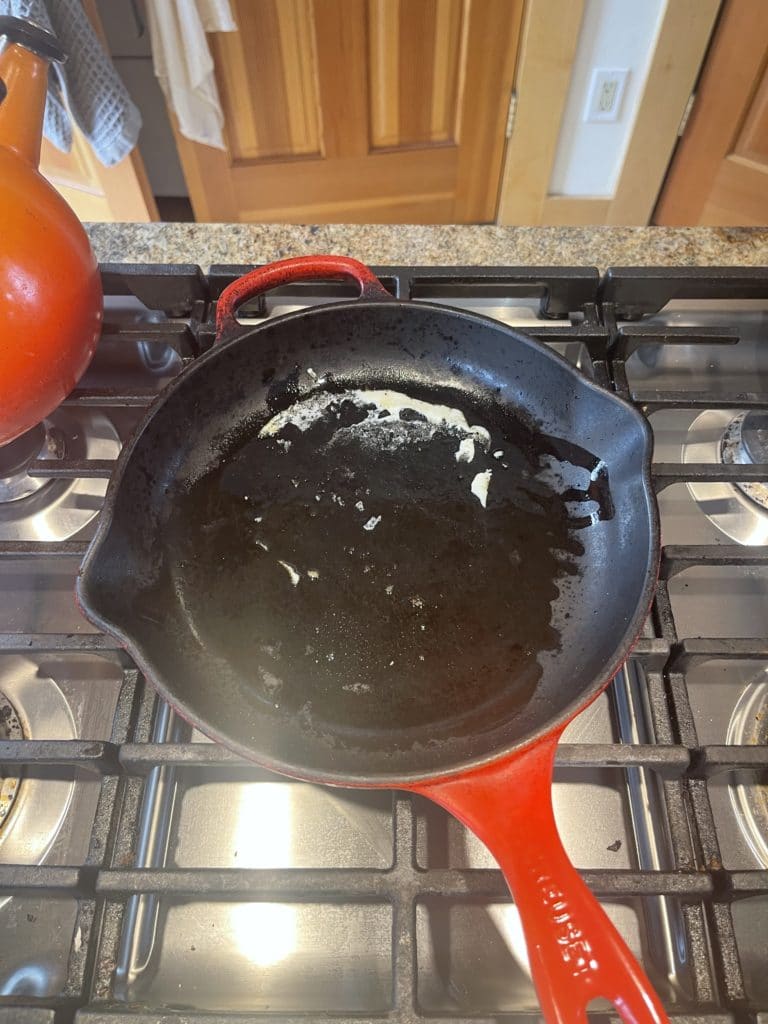
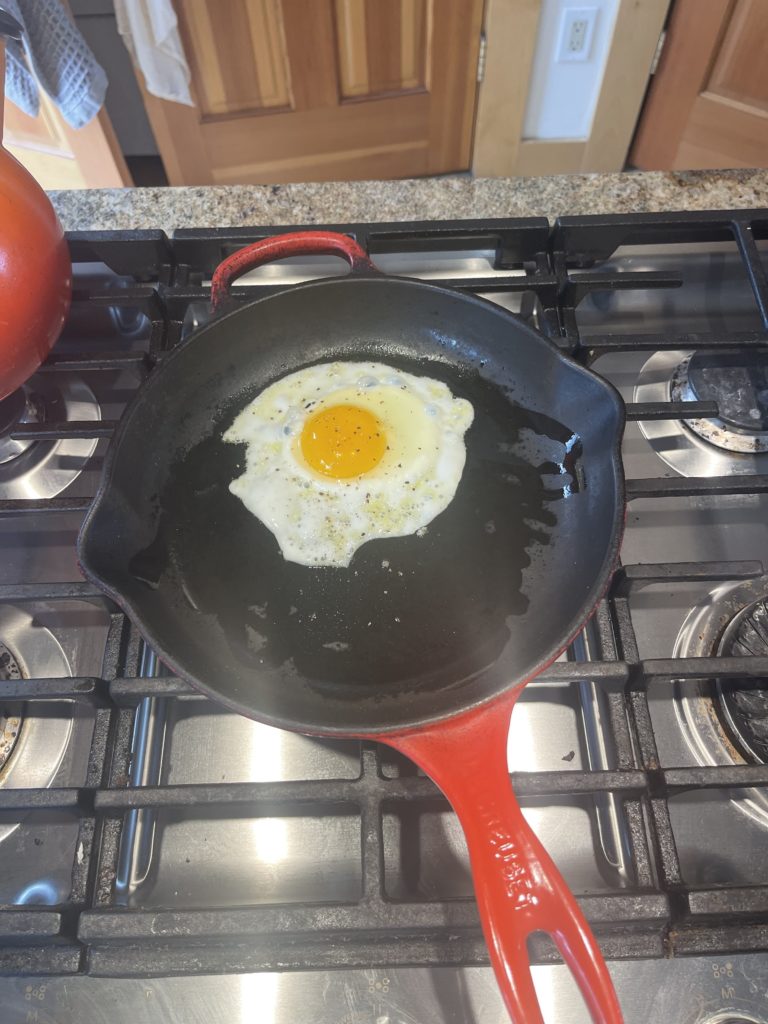
Nonstick Pans: What To Toss
Many nonstick pans contain more than you bargained for. Avoid using any pan made from the following materials.
Teflon (PTFE)
Teflon, the trademarked version of polytetrafluoroethylene, was considered a game-changing cooking agent when it entered the market 80 years ago. Until 2013 this nonstick coating often contained PFAS and other compounds like PFOA (perfluorooctanoic acid).
Teflon coatings break down at high heat (anything over 464℉), potentially releasing toxic fumes.
Newer Teflon pans claim to be PFOA-free, but they still contain other compounds, such as a PTFE coating. Avoid older Teflon pans at all costs, and consider staying away from newer ones as well.
Aluminum
Uncoated aluminum is highly reactive to acidic foods like tomatoes or vinegar.
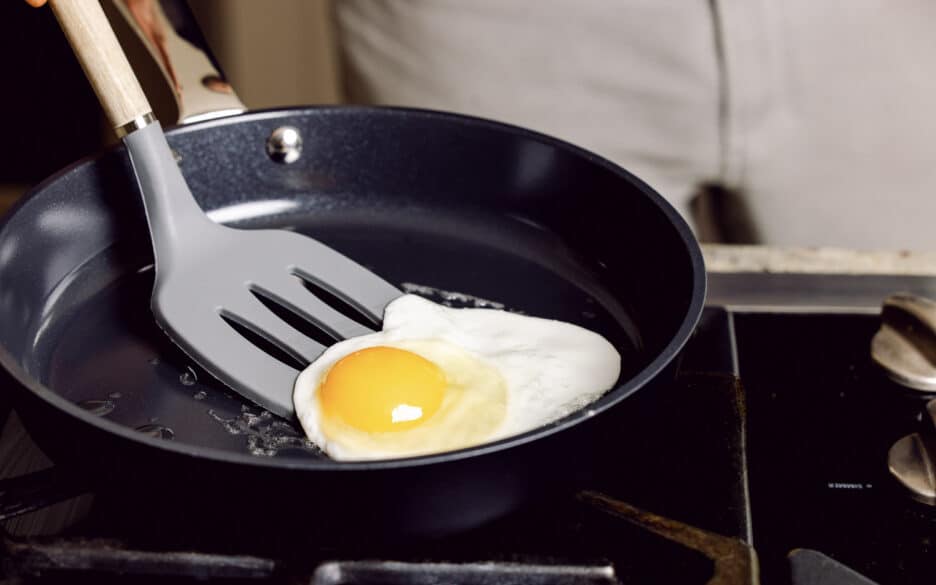
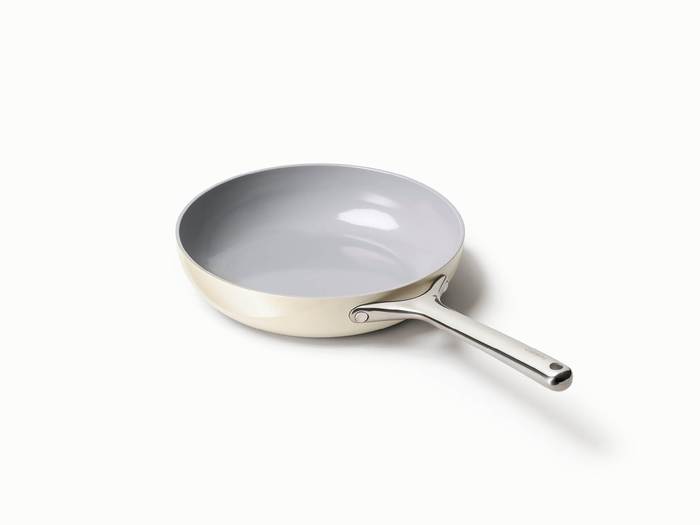
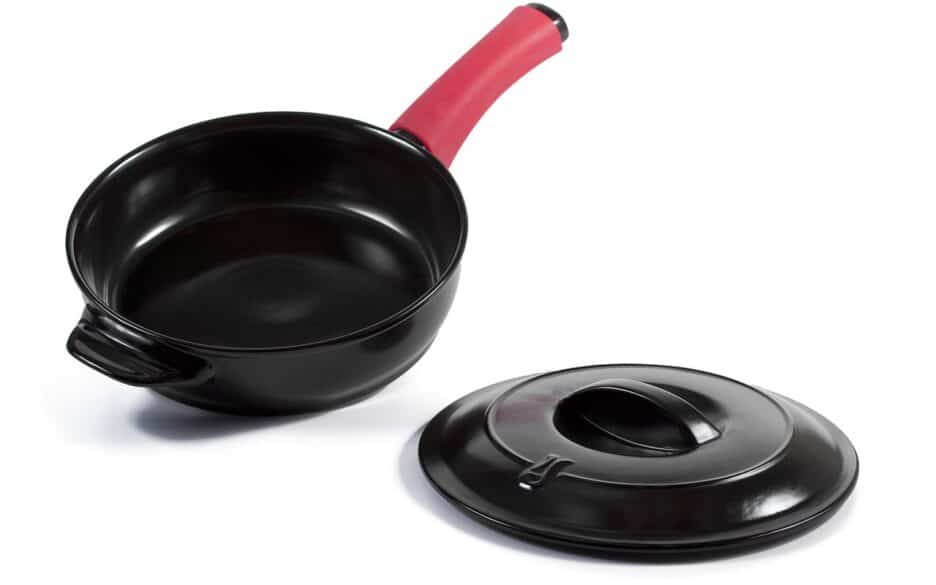

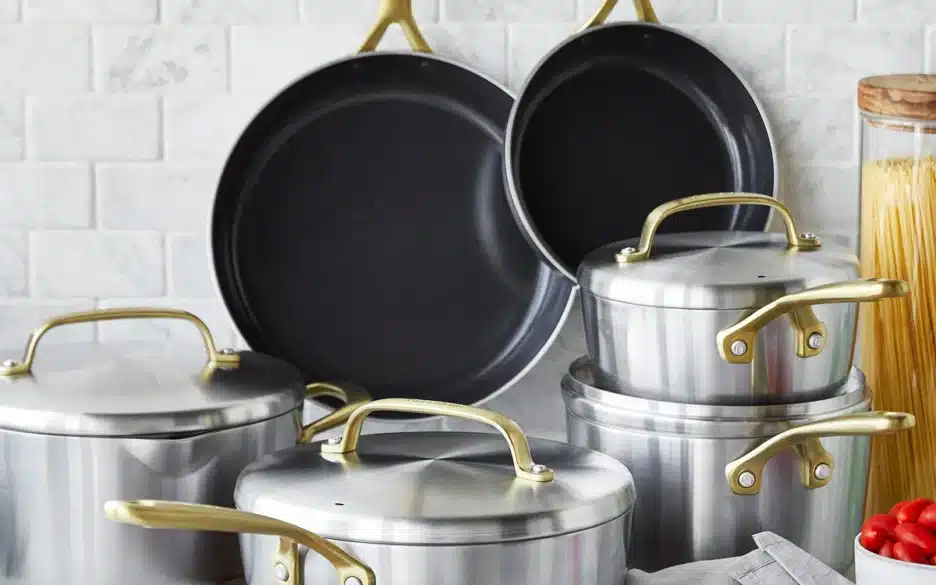
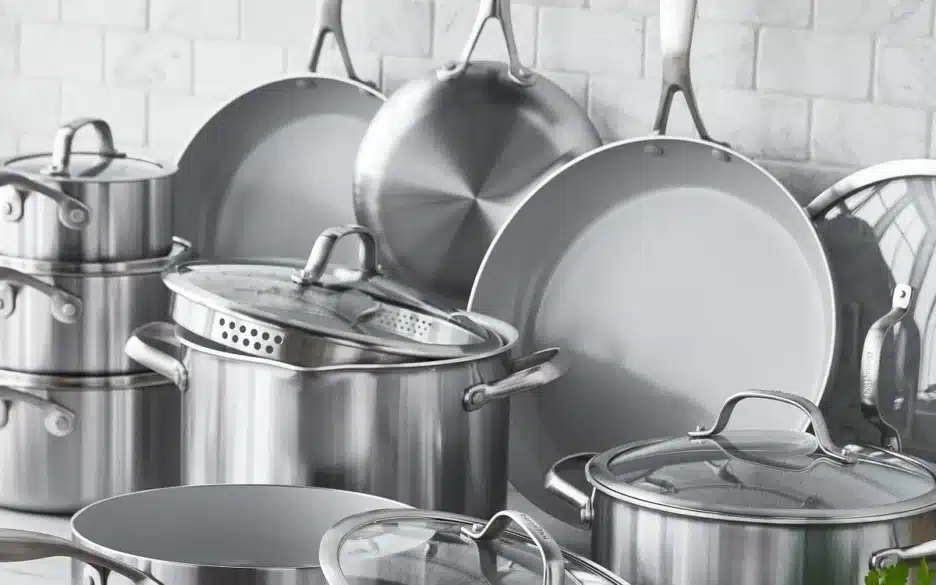
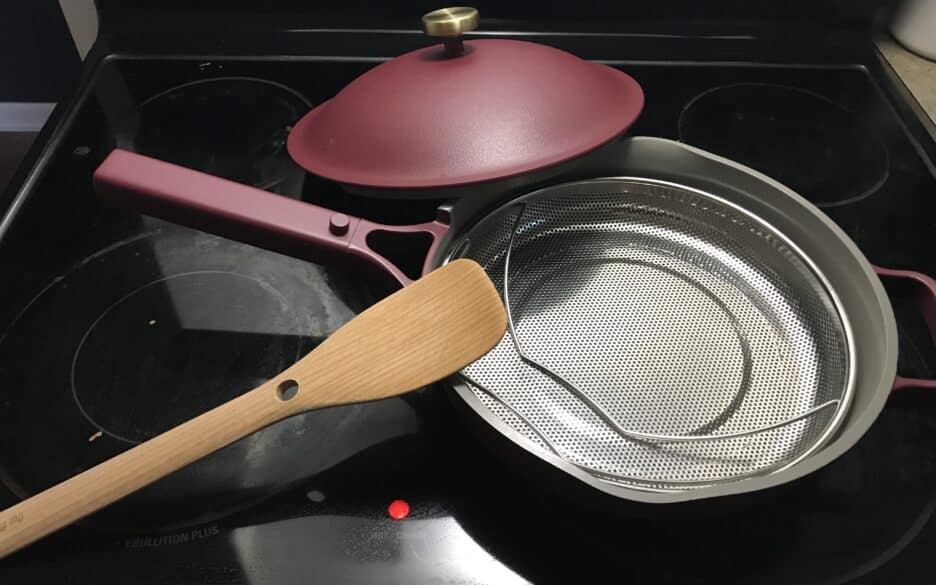
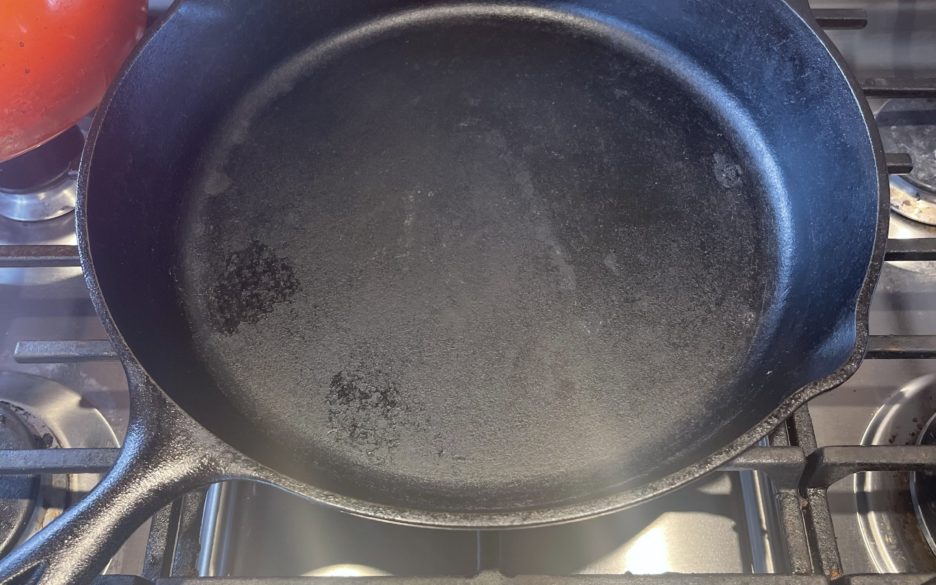
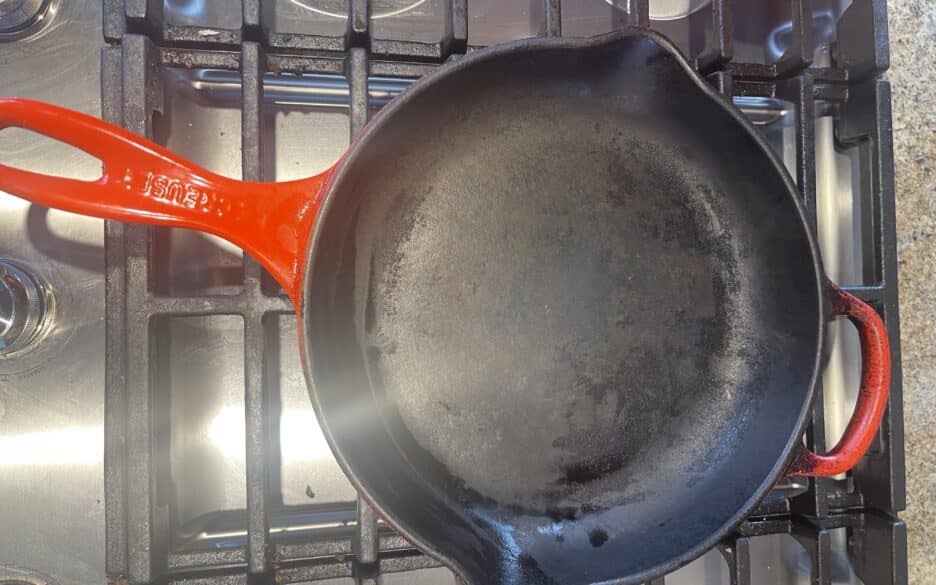
Great reviews…Im going for the Le Creuset
Amazing thank you so much
Thank you! What an eye opener. That was a very enlightening read.
What about non toxic non stick pans made in USA, sourced in USA or EU?
So informative thank you. I am considering buying Sardel nonstick skillets. Are they safe to use ?
Thank you
Hi Olivia,
I took a quick look and it seems Sardel use PTFE coatings. As such, we wouldn’t recommend them.
Leigh
Isnt anything safe to eat or cook with.
Who is responsible if you get sick from these cookware
I’ve asked to Zwilling brand for some clarification and they told me that the Madura Plus series are coated by PTFE (Teflon).
They did not using anymore PFOA like solvent for PTFE treatment, but remain that the pans are not PTFE free.
They didn’t mention PFAS
Great info and advice and honest in respect of saying that some food might stick. I was horrified when I learnt of forever chemical used in cookware.
I’ve had Le Creuset for a while. I was disappointed that things stuck when I first purchased. But there are processed you need to follow. Season your pan! Don’t over wash / over scrub. Soak to loosen anything stuck with a little dish soap. Let the patina build up. Heat the pan for a while first. Don’t use highest setting, on my induction I go to 7 (out of 9). Once hot add a little oil.
It may sound like more fuss but at least you aren’t destroying the world water supply and risking your heath.
And, use a silicone mat on you baking sheets.
GreenPan, Caraway, and more have LEAD, cadmium and more. Same with KitchenAid blades . Many items from potterybarn, crate and barrel which also test positive for lead.
Please do a report on cookware, bakeware, and dishware for lead, cadmium and pfte.
Hi, have you seen some of the testing lead free mama has done on some of the “non-toxic” pans you have on the list? Many have tested positive for heavy metals like caraway.
Hey Sant, yes, we saw Lead Free Mama’s blog post. Here is Leigh’s lengthy analysis: https://www.leafscore.com/eco-friendly-kitchen-products/answering-reader-questions-about-caraway-cookware-and-greenwashing/
Interesting article. Can we address the elephant in the room though? Allclad did NOT make the top ten non stick cookware list. Personally, I swore off Allclad’s not stick offerings long ago after finding GreenPan.
Per Crueset’s own website, their cookware include PTFE, do you have any more details?
https://www.lecreuset.com/california-chemical-disclosures-for-cookware-ab1200.html
https://www.lecreuset.com/california-chemical-disclosures-for-cookware-ab1200.html
Thanks Peter (and others who sent me this link!),
I amended the wording of the review to clear up any confusion. I believe Lydia meant to suggest only that the enameled cast iron was PFAS-free, not all Le Creuset products.
I’ve also added in a specific caution over Le Creuset’s non-stick cookware for greater clarity.
Thanks,
Leigh
Hi there team
I am based in Australia and the range of non stick non toxic cookware is reduced. I was wondering if you have reviewed Cosmic Cookware? If so, could you please point me in the direction of the review. Thank you very much for your help I appreciate it.
Hi Coral, we did a roundup of Australian cookware, here: https://www.leafscore.com/eco-friendly-kitchen-products/cookware/cookware-in-australia/
de Buyer uses PTFE in their nonstick cookware, per their website, which they attempt to greenwash: https://www.debuyer.com/en/blog/post/revetement-antiadhesif-distinguez-le-vrai-du-faux.html
Hi Jake,
Thanks for the comment. Yes, some De Buyer pans are made with PTFE, alas.
We only recommend the non-PTFE ones and wish De Buyer (and other cookware makers) would ditch the forever chemicals… forever!
Have you used the Mineral B pan or any others on this list? Would love your thoughts and feedback!
Thanks,
Leigh
I use the deBuyer carbon steel skillet, also Lodge cast iron, both seasoned. They are similarin seasoning, care, and cooking features. Many reviewers note or comment that because of a small plastic deBuyer button a d special laquered handle coasting, their Moneral B skillet is not safe in the oven: I-fixed that—burn it off in a 450F barbeque upside down and forget about it. Now you own a 100% carbon steel skillet.
Hi would you please be able to review RedChef? Thank you
Hello!
Thanks for the very useful list.
Have you all found any non-aluminum non-stick options that you would recommend? If you open up any “Prescription for Nutritional Healing” book it essentially says “where’s your aluminum exposure? That may be contributing to your health problems.” I see that almost all the real non-stick options all are made of aluminum. I currently use Le Creuset enameled cast iron (though there’s some question on their use of heavy metals), but was looking for 1 more pot or pan to add to my kitchen collection that’s maybe either cheaper or lighter or both. If not, I’ll just wait until I can afford another Le Creuset enameled cast iron and add that to my collection.
I read your piece from December 2023 in which you explain why you no long recommend GreenPan. But I see that this article is updated more recently and includes two different GreenPan lines. Does this mean that you are still recommending these pans or is this information outdated?
Hey Jimbo, the Greenpan piece is about to be overhauled. We have issues with their transparency, but the brand has been building pans with top-notch durability and 3-ply construction, so the Greenpan rating has become more complex. Update coming shortly.